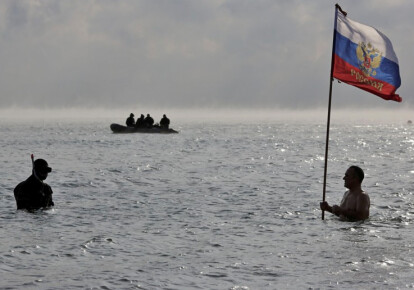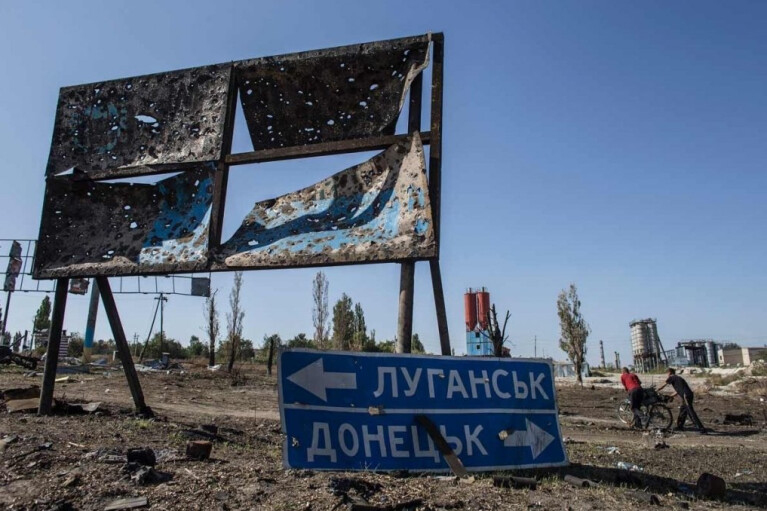Chinese strategy of the Kremlin. Why denunciation of the agreement on Azov does not help us

The Russian Federation will continue the policy of restrictions for shipping in the Sea of Azov as part of the development of the A2/AD zone (anti-access and area denial) strategy and its expansion in the region. It may be interested in the dissolution by Ukraine of existing agreements on the Sea of Azov and the Kerch Strait, taking into account the actual change of the operational situation in the region and the annexation of the Crimea. The actual control over the occupied peninsula and its political, economic and legislative integration into the structure of the Russian Federation allows the Kremlin to consider a scenario for unilateral revision of the Kerch Strait status.
According to the Treaty between Ukraine and the Russian Federation on cooperation in the use of the Sea of Azov and the Kerch Strait ratified in April 2004, the Sea of Azov is the domestic waters of both countries, where free navigation is provided.
The beginning of the Kerch bridge construction gave the Russian Federation a formal reason to increase security measures in the southern part of the Sea of Azov.
Russian Targets on the Sea of Azov
The Russian border guards, who are organizationally part of the Federal Security Service of the Russian Federation, systematically detain ships under different flags which are heading to the ports of Berdyansk or Mariupol and in the opposite direction for checking.
Thus, from the legal point of view, the detention and inspection of ships take place within the framework of the current legal regulation, although such precedents have not been observed previously. These measures in the Sea of Azov by Russia have a wide range of subversive goals and tasks.
Firstly, it is the destruction of the logistical model of economic entities on the territory of Ukraine. The increase of logistics costs, the disruption in delivery terms, the increase of the uncertainty factor will stimulate the counterparties of the Ukrainian enterprises to search for other partners and more reliable routes. Secondly, this will influence the local population, involved, in particular, in fishing and port operations. As a result there will be a spread of negative, anti-Ukrainian sentiments among the population and the formation of appropriate public opinion among those who suffer losses from the restrictions of navigation in the Sea of Azov. Thirdly, it is about preparations for the presidential and parliamentary elections in Ukraine in 2019 in the context of creating an additional program task for the pro-Russian forces.
The Kremlin does not consider the Sea of Azov as an independent section in a hybrid war with Ukraine. This is part of the interconnected concept of causing numerous "wounds" aimed at depleting the enemy and, ultimately, changing the political regime by internal forces without full-scale intervention.
Despite the total violation of the international law by Russia, in particular after the annexation of the Crimea and the occupation of Donbass, the Kremlin is trying to make its foreign policy, referring to the international documents and agreements. Since the occupation of the Crimean Peninsula, the military-political leadership of the Russian Federation has demonstrated its concernment with the legitimization of its decisions and actions and their justification from the international legal point of view. This predetermines the spread of new tactics: planning and conducting special operations or actions of influence (provocations) by special services of Russia with subsequent official reaction to them within the framework of the international legal norms. This allows the Kremlin to retain the formal legitimacy of the events and, at the same time, the offensive nature of its foreign policy.
Thus, it is unlikely that Russia will start an open confrontation in the Sea of Azov. However, it will provoke Ukraine into actions that can be assessed as aggression (attack), in order to obtain grounds for more radical steps and justify violation of the treaty norms. The main objective of the Russian Federation in this context is to obtain full control over the water area of the Sea of Azov and the Kerch Strait that will complete the process of transformation in the Azov-Black Sea basin, which are associated with the annexation of the Crimea.
Since summer of 2018, the Russian Federation has strengthened the maritime grouping in the Sea of Azov at the expense of the forces and means of the Caspian flotilla. In particular, to the occupied city of Kerch the following have been redeployed:
- "Grad Sviyazhsk" and "Great Ustyug" two missile corvettes
- three artillery boats (AK-201 and AK-248 of the project 1204),
- Six to seven "Serna" small landing crafts
- AK-326 patrol boat of the project 1400M,
- RVK-933 diving boat,
- RB-410 harbor tug.
The total number of ships and boats of the Russian Navy and the Russian Federal Security Service in the Sea of Azov is more than 40 units. The composition of the Russian grouping indicates rather an attempt to create a separate Azov flotilla than to prepare for a military operation in the water area.
Recall, that Russia is actively creating A2/AD zones. Novorossiysk is the center of these zones in the region. However, the strengthening of the group in the Azov basin may indicate the creation of another center of the A2/AD zones (possibly in Rostov-on-Don or Kerch). Thus, Russia borrows the Chinese model of creating similar zones in relation to disputed (in this case annexed) territories. Therefore, it is likely that the Kremlin is largely interested in limiting access to the northern regions of the annexed Crimea from the northeastern sea direction.
To break cannot be left
Ukraine is limited by the mechanisms for effective prompt response to the challenges in the Sea of Azov. The agreement between Ukraine and Russia on cooperation in terms of the Sea of Azov and the Kerch Strait usage was signed after the worsening of the situation around the island of Tuzla on the eve of the presidential election in Ukraine. Its content was contrary to the interests of Ukraine. Then the head of the presidential administration, Alexander Voloshin said at a briefing: "Russia will not leave the Kerch Strait to Ukraine. It is enough that the Crimea today is Ukrainian."
It is obvious that the conflict around Tuzla was initiated by Russia with the purpose of signing this document. Until then, the situation in the Sea of Azov and around the Kerch Strait could be regulated in accordance with the norms of the 1982 Convention on the Law of the Sea, which allowed Ukraine to establish a 12-mile zone of the territorial sea. This opportunity was lost after the signing of the treaty. De jure, according to the current legal regime, the Russian trade and military ships can approach the coastline of Ukraine in the Sea of Azov almost close-by.
Despite this, today the denunciation of the treaty does not solve the issue of the crisis and the threats that have arisen in the region. Despite the fact that it was the agreement that created the conditions for Russia's expansion in the Sea of Azov, its unilateral cancellation could lead to an even greater complication of the situation.
According to Article 2 of the treaty, the Russian Federation has no legal right to restrict the freedom of navigation in the Kerch Strait. The treaty was based on the recognition of the Crimea as a territory of Ukraine by both signatory countries. After the annexation of 2014 Moscow in its legislation consolidated the Crimea in the Russian Federation. Accordingly, the revision of the concept took place for the Kerch Strait.
The Kremlin, proceeding from the operational control of both banks of the strait, now claims for the sole control legally, which accordingly makes it impossible to enforce the other provisions of the treaty, in particular, for example, about merchant ships under the flag of the third countries that follow in or out the Sea of Azov. Thus, there is a high probability that the contract may not meet the interests of the Russian Federation already in the conditions of the Crimean Peninsula occupation.
To date, the a lawsuit filed by Ukraine in September 2016 in the Hague Court against Russia on the violation of its maritime law both in the Sea of Azov and the Black Sea refers to this treaty. Accordingly, Ukraine's unilateral withdrawal from the treaty nullifies its position in the international court, including the Black Sea issue.
Ukraine's withdrawal from the treaty will allow Russia to introduce independently the shipping regime in the Sea of Azov, as well as the passage within the Kerch Strait, since such actions will not be considered a violation of the norms of the treaty. As such, in case of termination of the contract by Ukraine, the initiative is passed to Russia, which will have the opportunity not to bear responsibility for its compliance at the international level.
The Kremlin will not denounce or break the treaty by itself, because it will give a chance to Europe and the United States to accuse it once again of violating international agreements and increase the sanctions pressure. The Russian leadership understands that time is in its favor and expects that in case of provocation against Ukraine it will be able to demonstrate the "unconstructive" behavior of Ukraine and use the "symmetric answer" within the strategic goal in the region, i.e. to gain full control over the Sea of Azov and the Kerch Strait.
Today Russia can be satisfied with the scenario of the loss of the strength of the treaty and the transition to the norms of the Convention on the Law of the Sea of 1982.
Combined strategy
The Kremlin will be able to regulate the regime of the Sea of Azov and the Kerch Strait with internal legislative acts, legality of which depends upon the recognition of the Crimean territory annexation. Thus, the legal return of control over the strait will become possible only after the recognition of the illegal annexation of the Crimea itself by the Russian Federation.
Denunciation of the treaty by Ukraine can be fruitful only if it is able to provide more than just security of navigation in the Sea of Azov, but also the unhindered passage of ships along the Kerch Strait. To date, this task is not real for several reasons. First of all, this is the lack of resources of the Armed Forces of Ukraine in the Sea of Azov, which would be able to provide a strategic and tactical advantage in the water area. The recent decision of the National Security and Defense Council, as for the creation of the naval brigade group of the Ukrainian Armed Forces in the near and probably even mid-term perspective will not improve the situation fundamentally due to its small number and limited technical and combat capabilities, in particular, the shortage of anti-ship missiles. Considering this, another factor is obvious: the full advantage of the forces and assets of the RF Armed Forces in the region, including the air forces component and coastal defense. It is also necessary to take into account the technical limitations of the capacity of the Kerch Strait as a result of the bridge construction.
However, even in the hypothetical case of achieving the ability to provide military advantage over the Russian Federation in the Sea of Azov, the power scenario for ensuring Ukraine's interests is inextricably linked with the open military confrontation between Ukraine and Russia, which goes far beyond the waters of the Sea of Azov, where the comparison of forces and means does not allow it to be viewed as an effective mechanism for implementing state policy of Ukraine in the Azov basin. Strengthening of the Ukrainian military potential in the region is absolutely the right strategy, but its implementation should be considered only in the long term perspective. The creation of the C2 structure on the basis of the A500 "Donbass" vessel transferred to Berdyansk is the beginning of the military group formation in the Sea of Azov, and the main lineup of this group will be completed later.
The scenario of launching the escorting of ships coming from or to the Ukrainian ports of the Sea of Azov is less risky in the short term perspective. However, it does not allow avoiding the ships check in the area of the Kerch Strait, and also there are no guarantees that mass verification of ships will not move to the south from the Kerch bridge, where the operational access of the Ukrainian Navy and maritime security forces of the State Border Guard Service of Ukraine is complicated.
Based on "win-lose" concept and evaluation, the solution to the problem of Russia's expansion in the Sea of Azov cannot be considered separately from the overall strategy to combat the Russian aggression in Ukraine and the liberation of the occupied territories. The incompatibility of the military potential of the parties limits Ukraine's ability to apply force scenarios only in cases of direct reflection of aggression of Russia.
That is why the most effective strategy is a combination of diplomatic and legal measures, including:
- the continuation of the filing of lawsuits against the Russian Federation, the maximum expansion of national sanctions against Russia;
- creation of a special regime for the activities of economic agents of the aggressor country in Ukraine;
- the state policy of ousting the Russian capital from strategic industries and infrastructure, including the media sector.
Thus, the identification of the problem of the Sea of Azov as an independent direction of counteraction to the Russian Federation is erroneous. It should be considered within the framework of unified state policy to restore territorial integrity of Ukraine and counteract the Russian aggression.
Read more:



